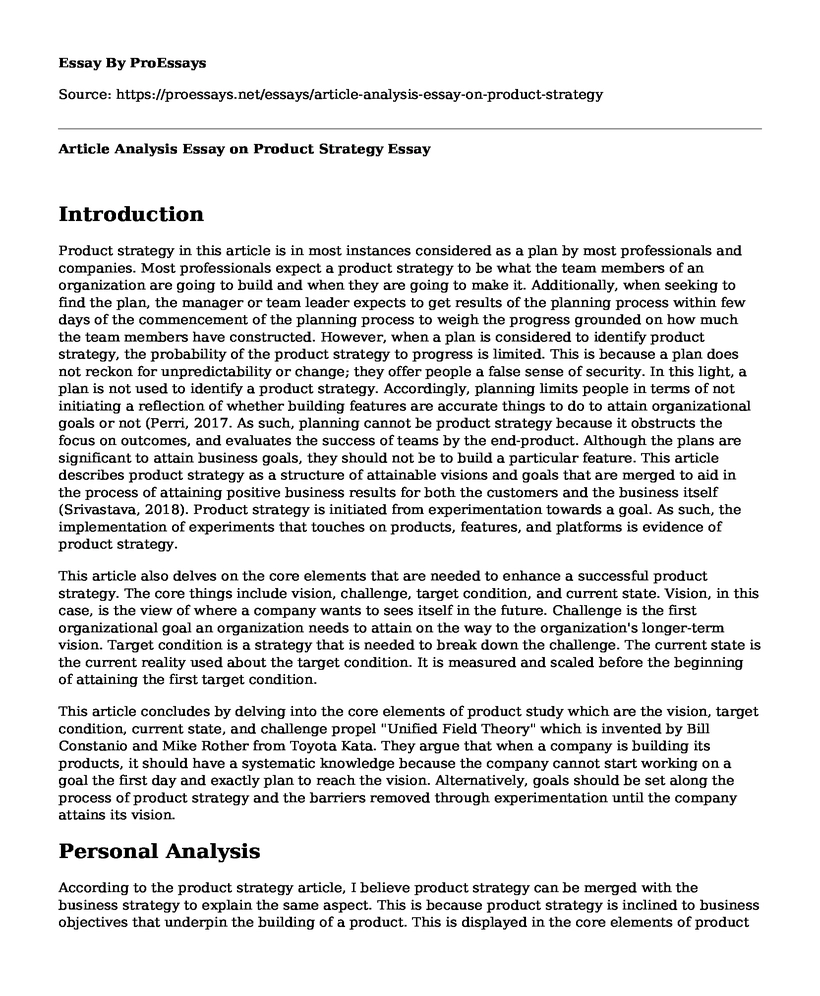Introduction
Product strategy in this article is in most instances considered as a plan by most professionals and companies. Most professionals expect a product strategy to be what the team members of an organization are going to build and when they are going to make it. Additionally, when seeking to find the plan, the manager or team leader expects to get results of the planning process within few days of the commencement of the planning process to weigh the progress grounded on how much the team members have constructed. However, when a plan is considered to identify product strategy, the probability of the product strategy to progress is limited. This is because a plan does not reckon for unpredictability or change; they offer people a false sense of security. In this light, a plan is not used to identify a product strategy. Accordingly, planning limits people in terms of not initiating a reflection of whether building features are accurate things to do to attain organizational goals or not (Perri, 2017. As such, planning cannot be product strategy because it obstructs the focus on outcomes, and evaluates the success of teams by the end-product. Although the plans are significant to attain business goals, they should not be to build a particular feature. This article describes product strategy as a structure of attainable visions and goals that are merged to aid in the process of attaining positive business results for both the customers and the business itself (Srivastava, 2018). Product strategy is initiated from experimentation towards a goal. As such, the implementation of experiments that touches on products, features, and platforms is evidence of product strategy.
This article also delves on the core elements that are needed to enhance a successful product strategy. The core things include vision, challenge, target condition, and current state. Vision, in this case, is the view of where a company wants to sees itself in the future. Challenge is the first organizational goal an organization needs to attain on the way to the organization's longer-term vision. Target condition is a strategy that is needed to break down the challenge. The current state is the current reality used about the target condition. It is measured and scaled before the beginning of attaining the first target condition.
This article concludes by delving into the core elements of product study which are the vision, target condition, current state, and challenge propel "Unified Field Theory" which is invented by Bill Constanio and Mike Rother from Toyota Kata. They argue that when a company is building its products, it should have a systematic knowledge because the company cannot start working on a goal the first day and exactly plan to reach the vision. Alternatively, goals should be set along the process of product strategy and the barriers removed through experimentation until the company attains its vision.
Personal Analysis
According to the product strategy article, I believe product strategy can be merged with the business strategy to explain the same aspect. This is because product strategy is inclined to business objectives that underpin the building of a product. This is displayed in the core elements of product strategy which include an organization or company's vision, target condition, challenge, and current state. The core elements are an echo in "Unified Field Theory" which is invented by Bill Constanio and Mike Rother from Toyota Kata. They argue that when a company is building its products, it should have a systematic knowledge because the company cannot start working on a goal the first day and exactly plan to reach the vision. Alternatively, goals should be set along the process of product strategy and the barriers removed through experimentation until the company attains its vision.
Additionally, my analysis identified that planning is not a method to be used in product strategy. This is because the plan does not reckon for unpredictability or change; they offer people a false sense of security. I also discovered that planning limits people in terms of not initiating a reflection of whether building features are accurate things to do to attain organizational goals or not. In this light, planning is not a considerable measure to be applied to product strategy. Instead, a company's vision, target condition, challenge and current state are the significant tools for a positive response from customers to attaining organizational goals.
References
Srivastava, M. (2018). New Product Strategy/Innovation: Challenges and Opportunities in Emerging Market. In Strategic Marketing Issues in Emerging Markets (pp. 99-105). Springer, Singapore.
Perri, M. (2017, June 26). What is Good Product Strategy? [Web log post]. Retrieved from https://articles.uie.com/what-is-good-product-strategy/
Cite this page
Article Analysis Essay on Product Strategy . (2022, Dec 02). Retrieved from https://proessays.net/essays/article-analysis-essay-on-product-strategy
If you are the original author of this essay and no longer wish to have it published on the ProEssays website, please click below to request its removal:
- The Gender Perspectives of Non-Profit Organization Leadership: Could Women Leadership Make More Committed Followers?
- Paper Example on Qatar Airways Strategy
- Action Research and Organizational Development Essay
- Situational Analysis for the Cocoa Delights Organization
- A Leadership Style Interview With the Philips Academy Manager Paper Example
- Essay Sample on Nokias Change Issues
- Multichannel Digital Marketing for Nike Paper Example







